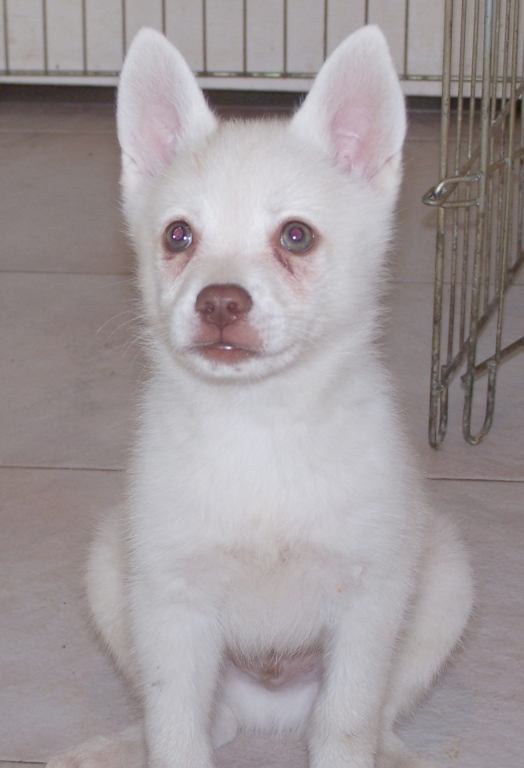|
About US Available
Retired AKK Our Males
|
Breeding for Color
Some have accused H.O.T. of breeding for color. Although we are
breeding a line that utilized Red and White dogs, we never breed SOLELY for
color. Health, Conformation, And Temperament should come before any cosmetic
traits to include mask traits, coat color, or eye color.
These examples involve the simple Black and Red genes in the
mating of two black and white or gray and white Alaskan Klee Kai and the likely
offspring from their mating. The likelihood of red offspring depends on both
whether the dogs carry the recessive red gene.
The pups will each inherit a dominant "B" for black from their
father as well as a dominant "B" from their mother. Red AKK result from a
straight ("homozygous") pair of recessive "b's" for red. No offspring will be
Red and no off spring will carry the red gene. None of the offspring will be
able to produce red factored or red puppies.
The pups will each inherit a dominant "B" for black from their father. The father has nothing else to donate. Red AKK result from a straight ("homozygous") pair of recessive "b's" for red. In a large sampling, statistically 50% of the pups will be Black BB (non-red carriers like their father) and 50% will be Black Bb (red-carriers like their mother). In any particular litter though, it is possible for all pups to be either BB or Bb. Remember that what it really is, is that each puppy has a 25% chance of being Red Factored. Not necessarily that 50% of the puppies will be.
The pups will each inherit a dominant "B" for black from their father. Red AKK result from a straight ("homozygous") pair of recessive "b's" for red. In a large sampling, statistically 50% of the pups will be Black BB (non-red carriers like their father) and 50% will be Black Bb (red-carriers like their mother). Again each puppy has a 25% chance of being Red Factored.
The pups will each inherit a dominant "B" for black from their
mother. Red AKK result from a straight ("homozygous") pair of recessive "b's"
for red. In a large sampling, statistically 50% of the pups will be Black BB
(non-red carriers like their mother) and 50% will be Black Bb (red-carriers like
their father).
Half of the pups will each inherit a dominant "B" for black from
their mother. (25% + 25%)
Each puppy would have 50% chance of being red. All the sire has to donate is red and the female has a fifty-fifty chance of donating red factor or not red factor.
No puppies would be red in this breeding. The sire has no red factor to contribute and the dam has nothing but red factor to contribute. So each puppy would carry the red gene but would not be red although one of the parents are.
*This example can be misleading. You would expect each puppy
to be red. But to throw a wrench into this example. You could also have a
white dog with a liver nose. White in our breed is not always a color but a
pattern, or should I say Lack of Pattern. So you could have a white dog that if
tested the color tested would show red. You would know the difference because
of the Brown/Liver points as opposed to the Black points. 
Some of this information was used with permission from
the "Colors of the Siberian Husky" website - www.huskycolors.com
|
| ||||||||||||||||||||||||||||||||||||||||||||||||||||||||||||||||||||||||||||||||||||||||||||||||||||||||||||||||||||||||||||||||||||||||||||||||||||||||||||||||||||||||||||||||||||||||||||||||||||||||||||||||||||||||||||||||||||||||||||||||||||||||||||||||||||||||||||
|
This site was last updated 07/29/12
Copyright © 2004-2012 |